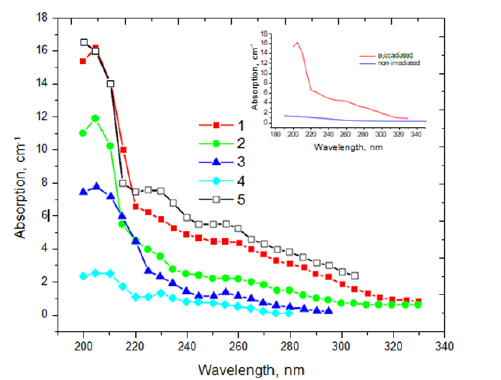- Submissions

Full Text
Research & Development in Material Science
Radiation-Induced Effects in Corundum
Harutyunyan VV* and Hovanessian AH
A.I. Alikhanian National Science Laboratory, Yerevan, Armenia
*Corresponding author:Harutyunyan VV, A.I. Alikhanian National Science Laboratory, Yerevan, Armenia
Submission: August 07, 2023;Published: September 13, 2023

ISSN: 2576-8840 Volume 19 Issue 3
Opinion
Aluminum oxide crystals, 𝛼-Al2O3, also called corundum, are of great scientific and practical importance due to their exclusive properties, namely, high hardness, refractoriness, chemical and radiation resistance, low electrical conductivity and high optical transparency in wide spectral range. Due to excellent radiation resistance and availability of highly developed growth technology for large-sized single crystals, corundum is widely applied in optoelectronics, thermonuclear reactors, as scintillation detectors, containers of hazardous materials, etc. [1-3]. Besides, luminescent properties of the material are extensively used in medicine and astronomical dosimetry. The increased radiation resistance of corundum crystals is of permanent interest in respect of the formation mechanisms of radiation defects (both point and complex ones), a part of which are Color Centers (CC), i.e., defects capable of absorbing or radiating quanta in ultraviolet (UV), vacuum ultraviolet (VUV), visual or infrared spectral ranges [2,3]. The purpose of this work is to reveal, at what stage of structural transformations the color centers are formed responsible for the “radiation memory” phenomenon, as well as to broaden the existing ideas on explanation of new and earlier obtained experimental results.
The subjects of study were samples of nominally pure (undoped) corundum (𝛼-Al2O3) single crystals grown by various methods - by horizontal-oriented crystallization (HOC) and Verneuil method. Concentrations of uncontrollable impurities in the reaction mixture were less than: 3⋅10-3% for Cr2O3, 10-4% for Ti2O3, 10-3% for Ca, Fe and Ni (in mass percent).
Crystals were irradiated with 50MeV electrons from “ARUS” YerPhI linear electron accelerator with doses 3*1017e/cm2, 2МeV reactor neutrons with doses ~1017n/cm2, X-rays and “white” beam of synchrotron radiation (hν~12keV). The optical absorption spectra were measured within 190-330nm range by means of a double grating monochromator.
Thus, in the presented work the existence of radiation-induced defects is proved in corundum crystals, formed as a result of irradiation by high-energy particles. Spectral distribution of the absorption spectra, the absorption band peaks caused by F, F+ color centers (Figure 1 & 2) are determined. The experimental results are presented confirming clearly the effect of thermal treatment on the behavior of the absorption bands, i.e. decrease of the absorption intensities within the investigated area. Based on these experimental regularities (irradiation, heat treatment), the mechanism of the “radiation memory” phenomenon as a result of repeated irradiation by X-ray quanta is offered.
Figure 1:Corundum optical absorption spectra (Verneuil crystal). Samples are irradiated with the dose of 3·1017 electrons/cm2. Curves: 1 - untreated sample; 2 - treated at 225 ℃ for 15min; 3 - 325 ℃ for 15min; 4 - 600 ℃ for 15 min; 5 - untreated sample, measured at 77К.

Figure 2:Optical absorption spectra of the irradiated (dose - 3·1017n/cm2) and thermal treated corundum crystals (HOC sample). Curves: 1 - treated at 700 ℃; 2 - X-ray irradiated during 90sec; 3 -150sec; 4 - 300sec; 5 - 450sec; 6 - 600sec.

The carried- o u t photo stimulation investigations (not brought here) have shown that when the F+ - center captures electron, excited F centers are formed which participate in the following recombination processes (with various durations):

where е and h are free electron-hole pairs formed during X-ray irradiation. From the obtained experimental results, it follows that the existence of F - centre and CC (302nm absorption band) enables to present them as complexes. The CC energy states are related, basically, to the aluminum charge states and can only enter into the complexes with anion vacancies as [Ali+F] centers [2]. The “radiation memory” phenomenon allows to explain the whole collection of experimentally revealed results of irradiation of solids from the united position. The study of radiation and optical properties of corundum single crystals in a wide spectral range has allowed to reveal and interpret the “radiation memory” phenomenon.
References
- McKeever SWS (2011) Rad Measurements 46:
- Makhov, Lushchik A, Lushchik Ch, Kirm M, Vasilchenko T, et al. (2008) Nuclear Instruments and Methods in Physics Research B 266: 2949-2952.
- Aleksanyan E, Kirm M, Vielhauer S, Harutyunyan V (2013) Radiation Measurements 56: 54-57.
© 2023 Harutyunyan VV. This is an open access article distributed under the terms of the Creative Commons Attribution License , which permits unrestricted use, distribution, and build upon your work non-commercially.
 a Creative Commons Attribution 4.0 International License. Based on a work at www.crimsonpublishers.com.
Best viewed in
a Creative Commons Attribution 4.0 International License. Based on a work at www.crimsonpublishers.com.
Best viewed in 







.jpg)






























 Editorial Board Registrations
Editorial Board Registrations Submit your Article
Submit your Article Refer a Friend
Refer a Friend Advertise With Us
Advertise With Us
.jpg)






.jpg)














.bmp)
.jpg)
.png)
.jpg)










.jpg)






.png)

.png)



.png)






